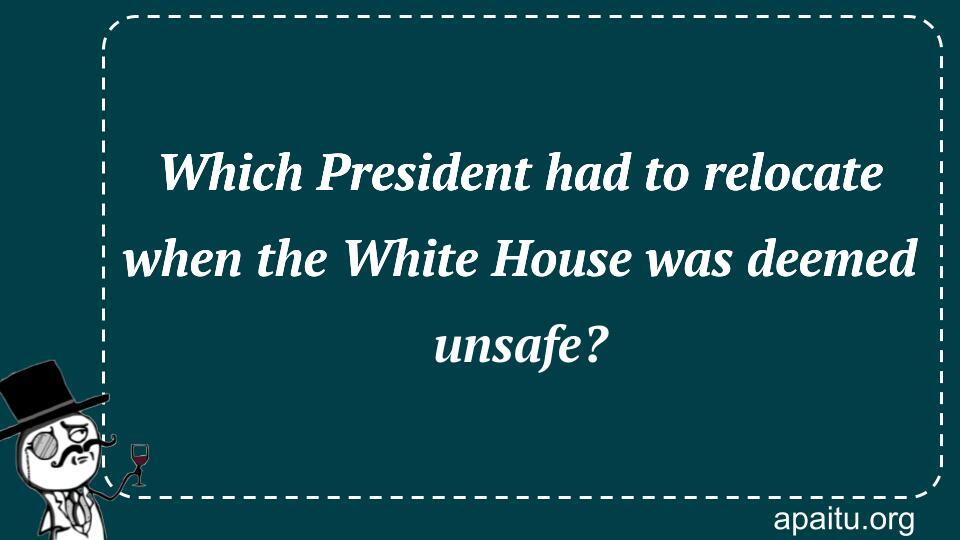Question
Here is the question : WHICH PRESIDENT HAD TO RELOCATE WHEN THE WHITE HOUSE WAS DEEMED UNSAFE?
Option
Here is the option for the question :
- Harry Truman
- Abraham Lincoln
- Andrew Jackson
- Gerald Ford
The Answer:
And, the answer for the the question is :
Explanation:
When President Truman moved into the White House in 1945, he complained about hearing popping and creaking sounds and joked that they were caused by ghosts. Engineers examined the building’s interior walls in 1948 and discovered that it was in grave danger of collapsing. The Trumans were relocated to the Blair House, the President’s guest house across the street, while the White House was disassembled and rebuilt, with a new steel skeleton added inside the old walls. In March 1952, President Truman returned to the White House and offered a live televised tour of the newly refurbished executive mansion.

Harry Truman: The President Who Relocated When the White House was Deemed Unsafe
The White House, the iconic residence of the President of the United States, has stood as a symbol of American democracy for centuries. However, there was a time when this historic building faced a significant threat, and the safety of its occupants was compromised. During the presidency of Harry Truman, the White House had to undergo extensive renovations, leading to the relocation of the president and his family. In this article, we explore the events that unfolded during Truman’s tenure and shed light on the circumstances that necessitated the relocation of the president.
It was in the years following World War II, during Truman’s presidency from 1945 to 1953, that the White House faced the need for urgent repairs. The building, which had stood since the early 19th century, had suffered from years of wear and tear. The structural integrity of the White House had deteriorated, with concerns arising about its safety and stability. It was determined that extensive renovations were necessary to ensure the preservation of this historic landmark.
The decision to undertake the renovations meant that Truman and his family would have to temporarily vacate the White House. The scope of the project was extensive, involving not only repairs to the building’s structure but also updates to its outdated infrastructure, including plumbing, electrical systems, and heating. To facilitate the renovations, Truman and his wife, Bess, relocated to Blair House, located just across the street from the White House.
Blair House, an elegant and historic townhouse, served as the temporary residence for the Trumans during the renovation period. The house, which was originally built in 1824, had become the official guesthouse of the President of the United States. Its proximity to the White House made it a suitable choice for the president’s temporary abode. Truman continued to carry out his presidential duties from Blair House while overseeing the renovation process.
The extensive renovations of the White House took nearly four years to complete. The project involved a team of skilled architects, engineers, and craftsmen who meticulously worked to restore and strengthen the building. The renovations not only addressed the structural concerns but also aimed to modernize the White House, bringing it up to contemporary standards of comfort and functionality.
Finally, in 1952, the renovations were completed, and the White House was deemed safe for occupancy once again. Truman and his family returned to their official residence, which now boasted enhanced structural integrity and modern amenities. The renovations had successfully preserved the historical significance of the White House while ensuring the safety and comfort of its occupants.
The relocation of President Harry Truman during the renovation of the White House highlights the commitment to preserving and safeguarding the symbol of American democracy. Despite the temporary displacement, Truman continued to fulfill his presidential duties with unwavering dedication and leadership. The extensive renovations undertaken during his tenure ensured that future presidents and generations would be able to experience the grandeur and historical significance of the White House.
Harry Truman faced the challenge of relocating from the White House when it was deemed unsafe during his presidency. The extensive renovations carried out during this period were essential to address structural concerns and modernize the building. Truman’s temporary residence at Blair House showcased his resilience and commitment to the office of the presidency, ensuring the preservation of the White House for generations to come.